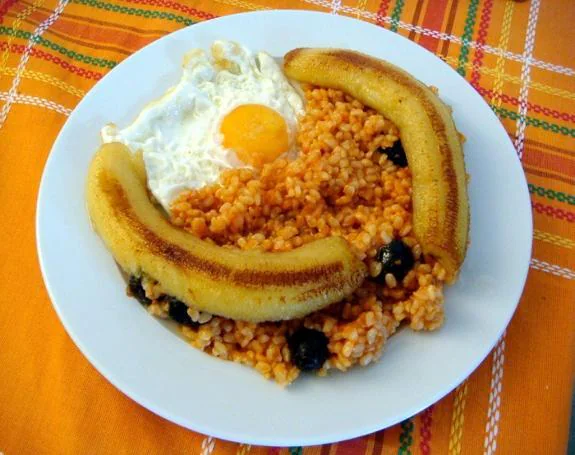

Secciones
Servicios
Destacamos

ANA VEGA PÉREZ DE ARLUCEA
Friday, 11 January 2019, 10:15
Just like the argument about whether a potato omelette should or should not contain onion, gastronomy also divides Spanish people into two different types with regard to 'arroz a la cubana', or Cuban rice, and whether or not it should have fried banana. I must confess that in my house we never ate it with that garnish, but maybe in Bilbao it was considered a bit too exotic to be decent. Still, some Spanish believe that Cuban rice without banana is like Christmas with no turrón,and that a version without it can only be inferior.
Apart from the banana qestion, what is really unusual about this dish is that it isn't really Cuban. Imagine if we went to another country and suddenly saw a rice dish which was completely unknown to us but was called 'Spanish style', and people there believed it was very typical of our country. If you don't believe me, ask any Cuban about the legendary episode of 'Con las manos en la masa' in 1985, when Alaska was trying to convince Elena Santonja that in Cuba, there was no such thing as 'arroz a la cubana'.
Something that is famous, much loved and regularly eaten in the pearl of the Carribean is white rice, a basic recipe which has been served as an accompaniment for virtually every type of dish for at least 200 years. Several recipe books from Cuba published in the 19th century referred to 'Creole rice', 'American-style rice' or 'Cuban rice', and it was simply boiled rice, sprinkled at the end with pork fat to keep the grains loose and delicious until the time to eat it.
"The rice in Cuba which is put on the table is white as snow, with grains separated like a pomegranate, and then eggs, fried banana, minced meat or any sort of sauce can be added," said Cuban journalist José del Perojo in 1891, when he sent the recipe to his friend Ángel Muro to be included in the 'Almanac of culinary conferences 1892'.
But where did the eggs come into it? And the tomato? Well, eggs were commonly eaten in Cuba in the mid-nineteenth century. Traveller Samuel Hazard ate a lot of them on his journey around the island and wrote about them in his book 'Cuba with pen and pencil' in 1871. Cuban hotels and inns used to offer boiled, fried, stuffed or stewed eggs for breakfast, as well as omelettes and accompanied by a wide variety of other products. As Hazard reported, there were "fried eggs with a spoonful of stewed tomato on top, which improves them a great deal. White rice is served with every meal and eaten alone with eggs, or tomatoes as well, which is called eggs with tomato and rice".
You see? The recipe was practically made. In 1858 in Spain a magnificent cookery book was published: 'La cocina moderna' by Mariano Muñoz included an 'American-style' rice, simply cooked, dressed with its bit of butter and served "for lunch with fried eggs". The thing is that this dish, which was a combination planned to fill you up quickly, didn't have a real name. In Cuba, white rice was white rice, and if anything, it was the eggs or other accompaniments that were known as 'Cuban-style'. That was also the name given to them by culinary genius Melquíades Brizuela in 1908, when he shared his version with the press (rice with fried banana and minced meat stewed with onion, garlic and tomato).
For many years plantain, cut into rounds and fried, was a basic garnish for many Cuban dishes, including 'lengua a la criolla', 'frijoles negros and 'carnitas or carne de puerco'.
At the end of the 19th century, different cookery books in America and Spain made Creole dishes, a mixture of Spanish and indigenous culinary traditions, popular. With the independence of Hispano-American countries a legion of exiles moved to Spain, returning home with their suitcases full of unusual flavours. While in Cuba the tradition of eating rice with eggs and tomato was lost, generations of families here recreated the flavours they missed, but had to adapt them because not all the ingredients were available in a Spain which was not as diverse or globalised as now.
That is why the typical white rice of Cuba was given another interpretation, with fried eggs, tomato sauce (instead of the pork fat), and fried banana. The first places in Spain to produce Cuban rice as we known it today were those with immigrants from Cuba, such as the Canary Islands, Asturias and Cantabria. A restaurant in Santander in 1912 was offering the dish as part of its menu of the day: soup, Cuban rice, hake with mayonnaise or steak with peas. It sounds like any 'menú del día' to be found in Spain today, although in those days it only cost three and a half pesetas.
Publicidad
Publicidad
Publicidad
Publicidad
Esta funcionalidad es exclusiva para registrados.
Reporta un error en esta noticia
Comentar es una ventaja exclusiva para registrados
¿Ya eres registrado?
Inicia sesiónNecesitas ser suscriptor para poder votar.